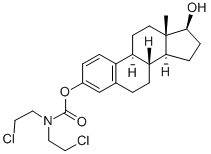Estramustine manufacturers
- Estramustine
-

- $39.00 / 5mg
-
2024-11-04
- CAS:2998-57-4
- Min. Order:
- Purity: 99.25%
- Supply Ability: 10g
- Estramustine USP/EP/BP
-

- $1.10 / 1g
-
2021-07-06
- CAS:2998-57-4
- Min. Order: 1g
- Purity: 99.9%
- Supply Ability: 100 Tons Min
|
| | Estramustine Basic information |
| Product Name: | Estramustine | | Synonyms: | 3,5(10)-triene-3,17-diol(17beta)-estra-3-(bis(2-chloroethyl)carbamate);LEO 275;1,3,5(10)-Estratriene-3,17β-diol 3-[bis(2-chloroethyl)carbamate];1,3,5(10)-Estratriene-3,17β-diol 3-[N,N-bis(2-chloroethyl)carbamate];Estamustine;estradiol,3-(bis(2-chloroethyl)carbamate);ESTRAMUSTINE;Estramustin | | CAS: | 2998-57-4 | | MF: | C23H31Cl2NO3 | | MW: | 440.4 | | EINECS: | 221-076-3 | | Product Categories: | | | Mol File: | 2998-57-4.mol |  |
| | Estramustine Chemical Properties |
| Melting point | 104-105° | | alpha | D20 +50° (in dioxane) | | Boiling point | 565.8±50.0 °C(Predicted) | | density | 1.253±0.06 g/cm3(Predicted) | | storage temp. | Store at -20°C | | form | Solid | | pka | 15.05±0.40(Predicted) | | color | White to off-white | | Water Solubility | 1mg/L(30 ºC) | | CAS DataBase Reference | 2998-57-4(CAS DataBase Reference) |
| | Estramustine Usage And Synthesis |
| Uses | Estradiol 3-[N,N-Bis(2-chloroethyl)carbamate] is used treatment of breast cancer. Also used in the treatment of prostate cancer. | | Uses | Antineoplastic. | | Definition | ChEBI: A carbamate ester obtained by the formal condensation of the hydroxy group of 17beta-estradiol with the carboxy group of bis(2-chloroethyl)carbamic acid. | | Indications | Estramustine phosphate sodium (Emcyt) is a hybrid
structure combining estradiol and a nitrogen mustard in
a single molecule. The drug has been approved for use
in prostatic carcinomas and will produce clinical remissions
in one-third of patients who have failed to respond
to previous estrogen therapy. The mechanism of
action of estramustine is not well defined, but it does
not appear to require either alkylation of DNA or the
presence of estrogen receptors in tumor cells.
Nonetheless, the toxicities of the drug are similar to
those of estrogen therapy: breast tenderness and enlargement
(gynecomastia), fluid retention, mild nausea,
and an increased risk of thrombophlebitis and pulmonary
embolism.The drug is not myelosuppressive. | | Biological Functions | Estramustine has a low affinity for the βm tubulin isotype, which often is overexpressed in estramustine�resistant prostatic neoplasms as one defense against this therapeutic intervention. | | Mechanism of action | Because this anticancer agent contains a carbamylated nitrogen mustard moiety, it is most commonly classified as a DNA alkylator; however, it is now known that its primary mechanism of antineoplastic action is inhibition of mitosis. |
| | Estramustine Preparation Products And Raw materials |
|